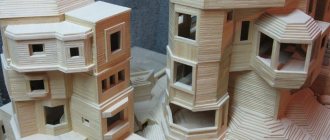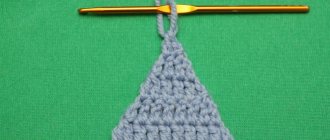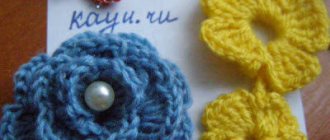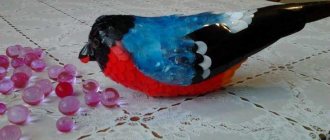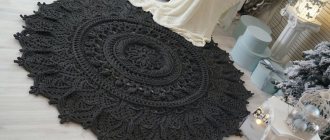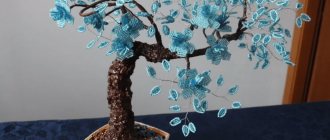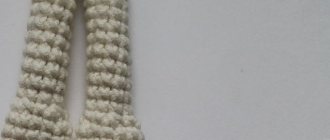Rating: 4.57/5 (14)
The first shawls appeared in Europe during the Napoleonic campaigns and were literally worth their weight in gold. Eastern gifts were appreciated by women of all classes, and craftswomen began to master a new type of needlework. A beautiful cape can transform even the most laconic outfit into the festive category . And it is with crochet that those very openwork weaves for airy shawls are created, for which Slavic crafts have long been famous.
How to choose a pattern for a shawl
Looking through photos of shawl knitting and dozens of finished products with detailed descriptions, it’s difficult to stop at just one thing. It’s just eye-opening - each of them is good in its own way.
When choosing just one, it is important to understand that everything depends on taste, experience, degree of crochet proficiency and ability to read a pattern.
For beginners, a smooth triangle with a border around the edges is suitable. The simplest variations:
- fabric with a mesh of air loops or square cells (fillet);
- a nasty base of single crochets or half crochets;
- simple patterns of 2 repeat rows with expansion in the center;
- accessible diagrams that are easy to read even for a beginner.
Some products are too labor-intensive - they take several months to knit. For example, if it is a freeform technique or Irish lace, then it takes years to master it, achieving perfection. Without experience, such a shawl will not have the classic shape - triangular or fan-shaped.
Tying the edge of the shawl with a long fringe
A fringe that is not just made from cut pieces of thread, but is made from knitted air loops will look beautiful.
Description of work:
Prepare the edge of the product if it is not smooth or has small flaws. To level the product, you need to tie an RLS around the entire perimeter of the product.
Next we knit according to the pattern, in the first loop we knit a sc and * cast on 15 VP in the 11th loop from the beginning of the cast-on chain, we knit a dc, we cast on 4 VP and with a connecting stitch we knit into a loop with a sc, we cast on 11 VP and a sc in the fifth loop from the beginning of knitting, we finish the rapport * we continue from* to* to the end of the row.
For variety, the length of the fringe can be changed by decreasing or adding air loops in each repeat.
It will look like this:
Video tutorial on creating fringe with knots at the ends:
What yarn to knit a shawl from
The feeling of warmth in knitted items comes not from a dense pattern or thick bobbins, but from the high quality of fine yarn. Thick polyester thread is suitable for bags, ottomans or rugs. The more rabbit fluff, goat or dog mohair on the thread base, the warmer the product.
Note! “Mink Down” does not exist, it is a commercial name. Typically, the composition is semi-synthetic yarn with the addition of rabbit fluff.
Remember the very warm Orenburg down scarves, shawls and stoles from grandma’s chests - they are made of very thin thread. Once they said that the product could be pulled into the eye of a gypsy needle, but they were very warm. It is a pity that many ancient techniques and patterns for knitting shawls have been irretrievably lost.
Yarn made from natural wool looks good and keeps you warm on cold days. But it shrinks during washing, especially when rinsing in cold water. Manufacturers do not always honestly indicate the percentage of wool and synthetics, especially if they are handicrafts.
On the other hand, artificial thread helps keep the shape of the product. And alternating with stripes of fluffy threads will add warm comfort to the product. For summer products, down and mohair are not suitable, only cotton, linen and viscose.
Important! Before knitting a shawl with your own hands from leftover yarn, make sure that it is of the same thickness and approximately the same quality in composition. Then the thing will turn out neat, as in the photo.
Note!
- How to knit sleeves with knitting needles: photos of stylish styles, instructions, diagrams, patterns for beginners
- Knitted overalls for newborns (130 photos) - DIY knitting methods + detailed patterns for beginners
- How to knit a shirtfront with knitting needles: TOP-110 photos + master class for beginners, simple patterns with detailed descriptions
Preparing for knitting
Even a person who is not endowed with outstanding skills in the field of creating clothes from gimp can knit a scarf with a crochet hook. To make such a wardrobe item with your own hands, you will need to use the diagrams and descriptions of patterns found in this article.
The activity will begin with the challenge of purchasing the right supplies and materials. Using the experience of professional knitters, there are several tips that will help you at this stage:- Yarn should be purchased for the entire product at once, perhaps even with a slight excess. If it runs out during the process, you risk not finding material of the same shade.
- Before purchasing, you should make sure that the thread in the ball is twisted tightly enough. The better it is tightened, the easier it will be for you to work.
The main rule regarding the purchase of a tool is to correctly select its diameter. The diameter of the equipment should be exactly three times the thickness of the thread used.
Please note: we do not recommend saving on rigmarole and buying cheap options, because the characteristics of the final product depend on the type of material.
You should not start training immediately after choosing a suitable model. Before you start weaving, it is better to practice and once again make all the necessary calculations, in which the sampler will help. After you finish two repeats and close the loops, you should stretch the sample and count the number of loops needed for the veil.
How to combine patterns and yarn
When starting work, you can never say exactly how big the shawl will be. Usually knit until the end of the bobbin or skeins prepared for the product. If there is a lot of thread left, you can make fringe or lush tassels.
A product that is too large will look luxurious, but it will be uncomfortable to wear. You often want to wear an openwork accessory around your neck under your outerwear, but it is too bulky. The only way out is to reduce the volume of the product, knit a small triangle, diluting the dense rows with a sparse mesh.
Here is an example of how the mesh beautifully alternates with the main pattern on not very thick threads; there is a photo of the pattern of a knitted shawl.
Which scheme is the best? Of course, one that is easy to knit and looks great in a project with existing yarn. Pineapples, spiders, eyes, roses and ethnic elements on the fillet mesh are popular.
Today, products made from “Kauni” - colored skeins of yarn with a gradient (a smooth transition from one shade to another) are considered fashionable. But the more complex the color scheme, the simpler the crochet shawl pattern should be.
Note!
- Knitting leopards with knitting needles - detailed instructions for knitting with your own hands + diagrams and templates for beginners (160 photos)
- How to knit a men's sweater: design ideas, DIY knitting instructions, patterns for beginners
- How to knit a blanket with your own hands - step-by-step instructions for knitting with your own hands + patterns for beginners (140 photos)
Video tutorials and descriptions on crocheting a shawl
Crochet shawl with spiders and lush braids
The video should load here, please wait or refresh the page.
Description of the Maria shawl, part 1
The video should load here, please wait or refresh the page.
Description of the Maria shawl, part 2
The video should load here, please wait or refresh the page.
How to crochet a shawl, job description
For knitting, I needed 2 skeins of yarn from Pekhorka “Crossbred Brazil” (composition: 50% merino wool, 50% acrylic, 100 g/500 m), I crocheted No. 2.5. Many women want to have an openwork shawl. After all, crocheted shawls are beautiful and unique in their own way. Using a crochet hook, such a product can be built in a few days. I suggest crocheting this openwork pattern with me. To do this, use the simple pattern diagram and my master class.
The video should load here, please wait or refresh the page.
Patterns and schemes from square motifs
If it is difficult for someone to understand the description of large-scale patterns, it is better to knit a product from identical small squares. They can be of different colors, but in the same range of the spectrum - warm or cold.
The only negative is that the square motifs must be the same size. When they try to assemble a product from squares that differ slightly in size, the result is not very neat.
It is easy to knit a shawl from squares according to the pattern, but it is difficult to sew them neatly. Where the last edge is formed with “teeth”, it must be supplemented with triangles (halves) to make the item look complete.
Patterns with fans and shells
The technique of knitting fans is quite simple, somewhat reminiscent of knitting individual squares or triangles. More skill and experience in crocheting will be required.
Important! Often, ready-made patterns for knitted shawls are presented very small. When enlarged, their symbols become blurred and make reproduction difficult. It is better to look for an analogue or abandon a similar pattern.
Some patterns were originally proposed by the authors for products based on patterns. Subsequently, they were adapted for shawl products and bacti.
Note!
Knitted toys - TOP 140 photos of the best options, simple patterns, knitting master class for beginners
- Crochet booties - simple instructions, design reviews + knitting patterns for beginners (170 photos)
Knitting a snood scarf with a description of the pattern: photos of beautiful options, a step-by-step master class on do-it-yourself knitting
Rachy step
The crochet step is a simple way to tie a product that does not require additions, but fixing the edges is necessary for the strength and durability of the product. Before you start knitting the crab step, pay attention to the edges of the product. If you notice any unevenness or changes, then first tie the product around the perimeter in each loop with a single crochet.
How to knit a crab step in order:
- The entire pattern is knitted in sc, please note that the knitting pattern does not go in the direction of normal knitting, but in the opposite direction, hence the name “backing in the opposite direction”;
- We insert the hook under two half-loops in the direction “away” from the previous row;
- Grab the working thread and pull it out;
- Two loops have formed on the hook;
- Knit two loops at the same time;
- Repeat all steps from point No. 2 to point No. 4.
To see more clearly how the crab step is knitted, watch the video lesson:
Schemes from the corner
There is nothing complicated in these descriptions. The main thing is to strictly adhere to the description and monitor the symmetrical expansion of the canvas. Classic - a smooth shawl with an openwork border. Sometimes they combine ready-made knitted fabric, knitted with knitting needles or a machine, adding a patterned stripe along the edges.
Helpful advice! Do not neglect the experience of others; some master classes on knitting a shawl will answer all the questions that arise along the way.
Knitting from a monitor is not very convenient. Print the selected diagram on A4 sheet. This will make it easier to make notes and number the rows.
The simplest knitting shawl pattern for beginners
I want to quickly knit some product, but I don’t have enough experience and time; there are many options for knitting simple patterns of knitted mohair shawls. This type of yarn will make a beautiful openwork item.
You can knit a shawl in parts and you can choose any openwork pattern you want.
Knit the middle of the shawl with the first chosen pattern, alternating yarn overs, knit 2, knit, knit 2. with a tilt to the left.
rows 5-23 13 times
Rows 5-15 – 1 time.
Knit the last rows of the middle of the shawl like this: 2 rows in stockinette stitch, 4 in garter stitch.
Do not close the loops and set aside the openwork part.
The edge can be knitted with a different pattern. First, make 9 loops with auxiliary yarn and knit several rows, using the main yarn, knit 1 row with knit stitches. Continue knitting according to the chosen pattern. Tie the edge in each odd row to the main fabric.
Having tied the entire fabric in the middle, connect the edges of the selvedge to complete the knitting.
The final result of the shawl depends on whether you need to block or stretch.
This way you can give the shawl the desired shape. Wet the shawl and lay it on the surface until dry.
This knitted mohair shawl will become the most favorite accessory in your wardrobe. Considering that the shawl can be worn both in winter and summer as a cape, few people will refuse such a universal item.
Description of shawls from the center
The easiest way to expand a knitted fabric is from the center. There are a lot of such descriptions today, they are accessible even to beginners. The formation of the expansion comes from the beginning of work - a closed ring. From it, the shawl gradually increases in size along the center line and symmetrically along the edges.
Most popular schemes are developed precisely on this principle of forming a triangular product.
Fan diagrams
A rarer variety is shawls in the shape of a semicircle or fan. They are distinguished by special grace and seem more complex in execution.
Each hand-made product is unique. But even a complex pattern is sometimes a pleasure to knit, and a primitive combination of stitches and chain stitches does not bring joy to work.
Helpful advice! The product should be pleasant to use. Therefore, it is better to choose a pattern where not only should the finished item look impressive, but it should be pleasant to crochet or knit. Otherwise, there is a high probability that the shawl will be sent to waste.
The work should only include those products that have accessible descriptions and easy-to-read diagrams.
Shawl with diamonds
Diamonds are a characteristic feature of vintage style. For such capes, threads of a mixed composition (alpaca and silk) in warm, rich tones are used. The size of the finished item is 170*60. This cape is crocheted using hook number 4.5. If you carefully look at the diagram, the work will take 8 – 10 hours. At the end, the top of the product needs to be tied with single crochet loops.
Schemes of author's products
Often in women's magazines there are photos of famous personalities wearing hand-made products. Perhaps none of your friends have yet described the original idea of knitting a shawl with your own hands, although in some communities, craftswomen are starting to develop new products.
Author's products are exclusive, and the one who invented it decides for himself whether to post a description of the model online. Experienced craftswomen can repeat any shawl pattern offhand without a diagram, but you should not repeat the color and all the details of an original product. There must be something of your own, for example, an original border trim.
Copyright is often violated, and this threatens trouble for those who take credit for the “invention” of this or that pattern. However, without a logo in the form of a watermark in a photo of a shawl knitting, it is difficult to challenge plagiarism. But there are popular products that may seem “new” to some, but they have already traveled around the world, and many people know their authors.
Materials and tools
- Yarn Alize Real, Kauni, wool with acrylic 40/60, 200 g.
- Circular knitting needles size 3 mm.
- Crochet hook number 3.
- Markers to indicate rapports.
Description of work
There are no edge loops in this shawl as such. At the beginning and at the end of the product, 2 knit stitches are immediately knitted, which are then worked in garter stitch. Up to the 7th row, increases are made by pulling a loop from the bottom row (1B).
- Cast on 6 stitches on the needles. Knit further: 2 knit, 1B, 2 knit, 1B, 2 knit.
- The loops are knitted.
- 2 scarf stitches, 1B, 4 knit stitches, 1B, 2 scarf stitches (10 stitches).
- 2 scarf, 6 purl, 2 scarf.
- 2 scarf stitches, 1B, knit 2, 1B, knit 2, 1B, knit 2, 1B, 2 scarf stitches (14 stitches).
- 2 scarf, 10 purl, 2 scarf.
- 2 scarves, *yo, 1 knit*, repeat 10 times, at the end yarn over, 2 scarves.
- All paired rows are purl-wise according to the pattern, taking into account 2 scarves on each side.
- Repeat the pattern marked in pink 21 times.
- Repeat the loops marked in blue until the number of loops located in the diagram on the left remains. Knit them according to the black and white pattern. Repeat the yellow pattern until the last 2 scarf stitches.
- When scheme 1 is completed, you should proceed to scheme 2.
- In row 27, the spokes can be changed to slightly larger 3.75 mm. In the 63rd row - by 4.25 mm.
Scheme 1
Scheme 2
To finish knitting a shawl, you need to take a hook.
Knitting instructions:
- From 3 loops on a knitting needle, pull out one, then 9 chain loops.
- The motive is to continue in the outer circle until the end.
- Then turn the shawl.
- Start with 3 b/n columns along the chain, *9 ch, 1 b/n column under the arch from the bottom row*.
- Then draw between the stars around the entire circumference.
- The finished shawl needs to be steamed, unfolded, blocked with pins and dried.


